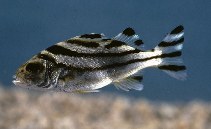|
Terapon jarbua (Fabricius, 1775) Jarbua terapon |

|
|
photo by
Cook, D.C. |
| Family: | Terapontidae (Grunters or tigerperches) | |||
| Max. size: | 36 cm TL (male/unsexed) | |||
| Environment: | demersal; freshwater; brackish; marine; depth range 20 - 350 m, catadromous | |||
| Distribution: | Indo-Pacific: Red Sea and East Africa to Samoa, north to southern Japan, south to the Arafura Sea (Ref. 9819), Australia, and Lord Howe Island. | |||
| Diagnosis: |
Dorsal spines (total): 11-12; Dorsal soft rays (total): 9-11; Anal spines: 3-3; Anal soft rays: 7-10. Diagnosis: This species is distinguished by the following characters: body oblong moderately and laterally compressed, greatest body depth 2.5-3.2 times in standard length; head length 2.3-2.6 times in standard length; lower opercular spine extending well beyond the opercular flap; posttemporal bone exposed and serrate posteriorly; pectoral fin rays 13-14; gill rakers 6-8 +13-16 = 19-24; pored lateral line scales 75-100; horizontal scale rows above lateral line 13-17; caudal fin emarginate (Ref. 48274, 90102). Description: Dorsal fin with 11-12 spines and 9-11 soft rays; anal fin with 3 spines and 7-10 soft rays; pectoral fin with 13-14 rays (Ref. 4327). Scales on lateral line 69-93 (Ref. 4327). Colouration: Colour of body silvery white with 3-4 curved dark brown or blackish stripes from the nape to the hind part of the body, the lowermost continuing across the middle of the caudal fin; spinous part of dorsal fin with a blackish blotch dorsally on membranes between third and sixth spines; caudal fin with stripes, the lobes with dark tips (Ref. 4327, 48274, 90102). |
|||
| Biology: | Found over shallow sandy bottoms, in the vicinity of river mouths. Enter estuaries and rivers (Ref. 1479, 11230, 44894, 48635), juveniles and adults are often found in freshwater (Ref. 4327). Adults in loose aggregations (Ref. 48635). Juveniles common in sandy intertidal areas; often in tidal pools. Minimum depth reported is 20 m (Ref. 12260). Found in schools (Ref. 9710). Omnivorous (Ref. 7300), feeding on fishes, insects, algae, and sand-dwelling invertebrates (Ref. 9710). Spawn in the sea and juveniles migrate into fresh water (Ref. 2847). Eggs are guarded and fanned by the male parent (Ref. 205). Produce sound (Ref. 9137). Caught on all types of inshore fishing gear including gill nets, traps, handlines, and bottom trawls and marketed fresh and dried-salted (Ref. 48274). | |||
| IUCN Red List Status: | Least Concern (LC); Date assessed: 20 June 2016 Ref. (130435) | |||
| Threat to humans: | harmless | |||